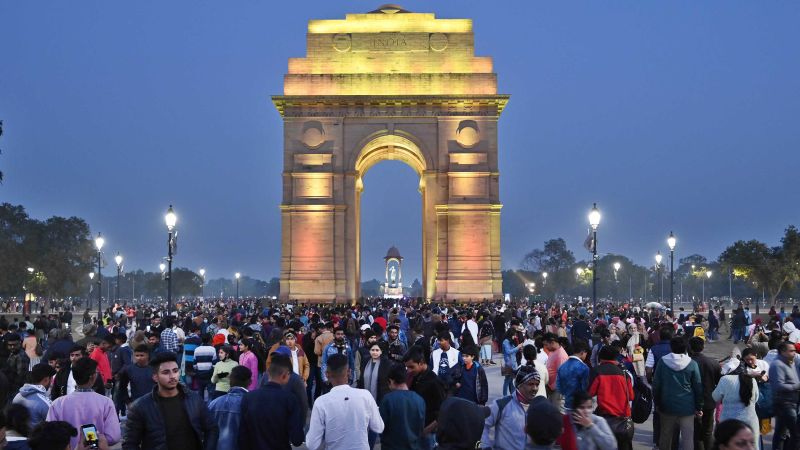
New Delhi
CNN
—
India will overtake China this year to become the world’s most populous country.
The likelihood of India passing that major milestone within a few months shot up Tuesday, when China reported that its population shrank in 2022 for the first time in more than 60 years.
This shift will have significant economic implications for both Asian giants, which have more than 1.4 billion residents each.
Along with the population data, China also reported one of its worst economic growth numbers in nearly half a century, underscoring the steep challenges the country faces as its labor force shrinks and the ranks of the retired swell.
For India, what economists and analysts call the “demographic dividend” could continue to support rapid growth as the number of healthy workers increases.
There are fears the country might miss out, however. That’s because India is simply not creating employment opportunities for the millions of young job seekers already entering the workforce every year.
The South Asian nation’s working-age population stands at over 900 million, according to 2021 data from the Organization for Economic Cooperation and Development (OECD). This number is expected to hit more than 1 billion over the next decade, according to the Indian government.
But these numbers could become a liability if policymakers do not create enough jobs, experts warned. Already, data show a growing number of Indians are not even looking for work, given the lack of opportunities and low wages.
India’s labor force participation rate, an estimation of the active workforce and people looking for work, stood at 46%, which is among the lowest in Asia, according to 2021 data from the World Bank. By comparison, the rates for China and the United States stood at 68% and 61% respectively in the same year.
For women, the numbers are even more alarming. India’s female work participation rate was just 19% in 2021, down from about 26% in 2005, the World Bank data shows.
“India is sitting on a time bomb,” Chandrasekhar Sripada, professor of organizational behavior at the Indian School of Business, told CNN. “There will be social unrest if it cannot create enough employment in a relatively short period of time.”
India’s unemployment rate in December stood at 8.3%, according to the Centre for Monitoring Indian Economy (CMIE), an independent think tank headquartered in Mumbai, which publishes job data more regularly than the Indian government. In contrast, the US rate was about 3.5% at the end of last year.
“India has the world’s largest youth population … There is no dearth of capital in the world today,” Mahesh Vyas, the CEO of CMIE, wrote in a blog post last year. “Ideally, India should be grabbing this rare opportunity of easy availability of labor and capital to fuel rapid growth. However, it seems to be missing this bus.”
Lack of high quality education is one of the biggest reasons behind India’s unemployment crisis. There has been a “massive failure at the education level” by policymakers, said Sripada, adding that Indian institutions emphasize “rote-learning” over “creative thinking.”
As a result of this toxic combination of poor education and lack of jobs, thousands of college graduates, including those with doctorates, end up applying for lowly government jobs, such as those of “peons” or office boys, which pay less than $300 a month.
The good news is that policymakers have recognized this problem and started putting “reasonable emphasis on skill creation now,” Sripada said. But it will be years before the impact of new policies can be seen, he added.
Asia’s third largest economy also needs to create more non-farm jobs to realize its full economic potential. According to recent government data, more than 45% of the Indian workforce is employed in the agriculture sector.
The country needs to create at least 90 million new non-farm jobs by 2030 to absorb new workers, according to a 2020 report by McKinsey Global Institute. Many of these jobs can be created in the manufacturing and constructions sectors, experts said.
As tensions between China and the West rise, India has made some progress in boosting manufacturing by attracting international giants such as Apple to produce more in the country. But, factories still constitute only 14% of India’s GDP, according to the World Bank.
With a 6.8% expansion in GDP forecast for this fiscal year ending March, the South Asian nation is expected to be the world’s fastest growing major economy. But, according to a former central banker, even this growth is “insufficient.”
“A lot of this growth is jobless growth. Jobs are essentially task one for the economy. We don’t need everybody to be a software programmer or consultant but we need decent jobs,” Raghuram Rajan, the former governor of the Reserve Bank of India, told media company NDTV, last year.
According to the Mckinsey report, for “gainful and productive employment growth of this magnitude, India’s GDP will need to grow by 8.0% to 8.5% annually over the next decade.”
